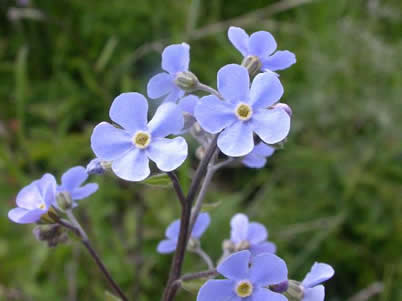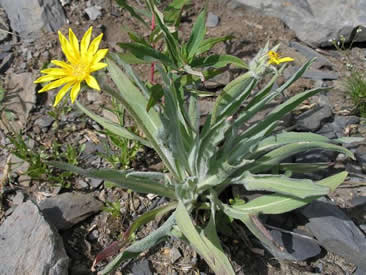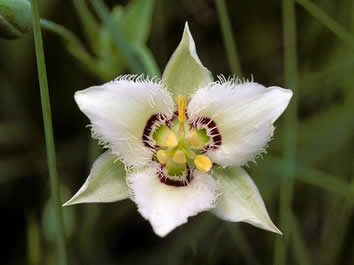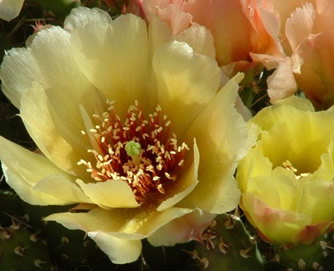INTRODUCTION TO VASCULAR PLANTS

Blue stickseed (Hackelia micrantha), photo by Jeremy Gatten.
by
Dianne Humphrey and Anna Colangeli
(Environmental Technology Program Camosun College)
To visit the E-Flora BC atlas pages for vascular plants, click here.
Introduction
Vascular plants are the most visible of all the plant groups. They are all around us and include those colourful wildflowers, weeds, and garden plants that we are all familiar with, such as wild roses, buttercups, cacti, lupines, dephiniums, daisies, and many many more. Our trees and shrubs are also vascular plants. In fact, most of the plants that you are familiar with are vascular plants. The exceptions are mosses, liverworts, algae and lichens, which are considered non-vascular plants.
1. What exactly is a ‘vascular’ plant?
Plants that can internally transport water and food are called vascular plants. The tissues which move water are separate from those which move food, but they are located adjacent to each other and are characteristically positioned in the roots, stems, and leaves of a plant. Some familiar plants allow us to readily see their vascular tissues, for example carrots and celery.
Carrots are roots and celery stalks are leaves. The ‘core’ of a carrot (what you see when you cut a carrot in half) is centrally located vascular tissue–characteristic of roots–with the water carrying tissue at the center immediately surrounded by the food carrying tissue.
The ‘strings’ of a celery stalk are actually bundles of water and food carrying vascular tissue. These are similar to the normal ‘circle of bundles’ construction in all green stems. In both examples, the water carrying tissue is found inside the food carrying tissue in what we call "a bunde".
The veins of leaves, usually prominent on the lower leaf surface, are also vascular tissue. In the veins, water carrying tissue is located above the food carrying tissue.

Short-beaked Agoseris (Agoseris glauca var. dasycephala). Photo by Curtis Bjork.
Those plants that are perennial increase in stem and root girth over time. They develop a dead layer (commonly known as bark) on their stem and root surfaces. They are said to exhibit secondary growth. These plants gain a ‘ring’ of water carrying tissue each year--added onto the outer surface of the previous rings. This is ‘wood’ and, for the most part, is made up of dead cells. The single layer of food carrying tissue is ‘soft’, living, located just beneath the ‘bark’, and continually pushed outward as the plant grows.
Pulling bark from the surface of a woody stem removes the food carrying tissue.
Girdling a tree completely prevents food from being transported from the leaves to the roots of vice versa.
Tapping Maple trees for syrup requires that a tap be inserted into the food carrying cells while they are mobilizing food, stored for the winter in the roots, back up to the buds. Young ‘inner bark’ can be quite sweet.
2. What are the basic features of vascular plants?
a. Anatomically, vascular plants possess roots, stems and leaves – all composed of cells with cellulose cell walls.
b. Vascular plants are autotrophic or self-feeding. They take in water through their roots, carbon dioxide from the atmosphere, and energy provided from sunlight. By the process of photosynthesis they create sugars. The green pigment chlorophyll is necessary for this process to occur, which is why most plants have green leaves.
c. Vascular plants don’t move. They are anchored to the substrate by roots.

Lyall's Mariposa Lily (Calochortus lyallii). Photo Ian Gardiner.
d. Vascular plants are vulnerable to drying out. All living tissues must remain hydrated and it is important for plants to absorb water (usually through the roots from the soil) and retain that water. There is a continual loss of water from photosynthesizing tissues, through little portholes called stomata, and therefore there is a constant need to replenish the water. Vascular plants use a variety of strategies to slow water loss and prevent dehydration. These include:
Waxy cuticle over exposed plant organs.
Compare the feel of an Arbutus leaf with a Maiden Hair Fern leaf. Which is adapted to heat, dry air, or wind? Look in the Photo Gallery within this website to see the leaves of Arbutus menziesii and Adiantum aleuticum (Maiden-hair fern), and other examples.
Reduced or protected surfaces in situations which are hot and dry.
Small thick leaves like conifer needles or heather leaves have reduced surface area. Fuzz on leaves slows water loss and shields the leaf from heat. Again, check the photo gallery for other examples.
e. Plants have to protect themselves from being eaten! They have adapted to have ‘prickles’, thorns, and spines. They also can store unpleasant tasting compounds. Sometimes a colour adaptation from pigments masking the green chlorophyll gives camouflage.

Prickly Pear Cactus (Opuntia fragilis), photo by Ted Edwards.
BC has two cactus species, which exhibit the spines/modified leaves typical of the cactus plant.
f. Reproduction requires that male and female gametes meet. If these gametes are from different parents within that particular type of plant then the genetic material is shared and mixed to allow genetic recombination.
All vascular plants have a dominant plant with two sets of chromosomes in each cell –the diploid state. They have a smaller haploid generation with only one set of chromosomes in each cell – the haploid state. In many cases, this small adult generation is not obvious.
In the non-seed plants, the male sperm swims to find the egg, so it is important that reproduction occurs in the ‘wet season’. Ferns and horsetails are examples of non-seed vascular plants.
In seed plants, the male sperm is transported to the location of the female egg by pollen grains which develop pollen tubes for sperm delivery. Sperm do not need an external source of water in order to reach the egg. Insects are the most important pollinators, but sometimes wind or water will do the job. Conifers are all wind pollinated, while flowering plants have the advantage of employing insect pollinators. A fertilized egg develops into an embryo in a seed.
Seeds have three component parts:
Worldwide vascular plant diversity indicates the great success of flowering plants. Not only do they utilize pollinators to increase the chances of reproductive success, but they also protect the new seeds within a fruit. Fruits exhibit much variation, but they all develop from the female ovary of a flower and contain seeds.
g. Most vascular plants partner with fungi within the soil to maximize their absorption of water and minerals. The partnerships are termed mycorrhizae.
To view atlas pages for vascular plants, go to our Species Search page.
REFERENCES
Douglas, George W., Del Meidinger and Jenifer Penny. 2002. Rare Native Vascular Plants of British Columbia. Province of British Columbia. Victoria.
Douglas, G.W., G.B. Straley, D.V. Meidinger, & J. Pojar. 1998. Illustrated Flora of British Columbia. Vol. 1: Gymnosperms and Dicotyledons (Aceraceae through Asteraceae). B.C. Ministry of Environment, Lands & Parks and B.C. Ministry of Forests. Victoria. 436 p. Crown Publications
Douglas, G.W., G. Straley, D. Meidinger, & J. Pojar. 1998. Illustrated Flora of British Columbia. Vol. 2: Dicotyledons (Balsaminaceae through Cucurbitaceae). B.C. Ministry of Environment, Lands & Parks and B.C. Ministry of Forests. Victoria. 401 p. Crown Publications
Douglas, G.W., D. Meidinger, & J. Pojar. 1999. Illustrated Flora of British Columbia. Vol. 3: Dicotyledons (Diapensiaceae through Onagraceae). B.C. Ministry of Environment, Lands & Parks and B.C. Ministry of Forests. Victoria. 401 p. Crown Publications
Douglas, G.W., D. Meidinger, & J. Pojar. 1999. Illustrated Flora of British Columbia. Vol. 4: Dicotyledons (Orobanchaceae through Rubiaceae). B.C. Ministry of Environment, Lands & Parks and B.C. Ministry of Forests. Victoria. 401 p. Crown Publications.
Douglas, G.W., D. Meidinger, & J. Pojar. 2000. Illustrated Flora of British Columbia. Vol. 5: Dicotyledons (Salicaceae Through Zygophyllaceae) And Pteridophytes. B.C. Ministry of Environment, Lands & Parks and B.C. Ministry of Forests. Victoria. 389 p. Crown Publications.
Douglas, G.W., D. Meidinger and J. Pojar (eds.). 2001a. The Illustrated Flora of British Columbia, Volume 6 - Monocotyledons (Acoraceae through Najadaceae). B.C. Minist. Environ., Lands and Parks and Minist. For., Victoria, B.C. Crown Publications.
Douglas, G.W., D. Meidinger and J. Pojar (eds.). 2001b. The Illustrated Flora of British Columbia, Volume 7 - Monocotyledons (Orchidaceae through Zosteraceae). B.C. Minist. Sustainable Resour. Manage. and Minist. For., Victoria, B.C. Crown Publications.
Douglas, G.W., D. Meidinger
and J. Pojar (eds.). 2002. The Illustrated Flora of British Columbia,
Volume 8 - General Summary, Maps and Keys. B.C. Minist. Sustainable
Resour. Manage. and Minist. For., Victoria, B.C.
Recommended citation: Author, date, page title. In: Klinkenberg, Brian. (Editor) 2021. E-Flora BC: Electronic Atlas of the Flora of British Columbia [eflora.bc.ca]. Lab for Advanced Spatial Analysis, Department of Geography, University of British Columbia, Vancouver. [Date Accessed]
E-Flora BC: An initiative of the Spatial Data Lab, Department of Geography UBC, and the UBC Herbarium.
© Copyright 2021 E-Flora BC.